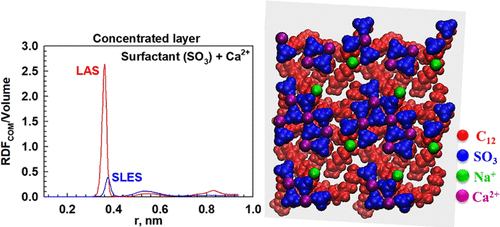Revealing the origin of the specificity of calcium and sodium cations binding to adsorption monolayers of two anionic surfactants

The studied anionic surfactants linear alkyl benzene sulfonate (LAS) and sodium lauryl ether sulfate (SLES) are widely used key ingredients in many home and personal care products. These two surfactants are known to react very differently with multivalent counterions, including Ca2+. This is explained by a stronger interaction of the calcium cation with the LAS molecules, compared to SLES. The molecular origin of this difference in the interactions remains unclear. In the current study, we conduct classical atomistic molecular dynamics simulations to compare the ion interactions with the adsorption layers of these two surfactants, formed at the vacuum−water interface. Trajectories of 150 ns are generated to characterize the adsorption layer structure and the binding of Na+ and Ca2+ ions. We found that both surfactants behave similarly in the presence of Na+ ions. However, when Ca2+ is added, Na+ ions are completely displaced from the surface with adsorbed LAS molecules, while this displacement occurs only partially for SLES. The simulations show that the preference of Ca2+ to the LAS molecules is due to a strong specific attraction with the sulfonate head-group, besides the electrostatic one. This specific attraction involves significant reduction of the hydration shells of the interacting calcium cation and sulfonate group, which couple directly and form surface clusters of LAS molecules, coordinated around the adsorbed Ca2+ ions. In contrast, SLES molecules do not exhibit such specific interaction because the hydration shell around the sulfate anion is more stable, due to the extra oxygen atom in the sulfate group, thus precluding substantial dehydration and direct coupling with any of the cations studied.

